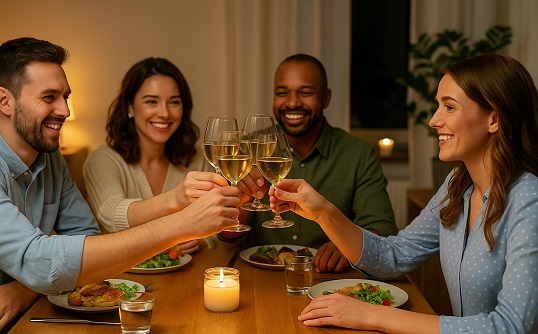
In Germany, meals are more than just moments of nourishment – they’re structured social rituals. And just as important as knowing when to say “Guten Appetit” is knowing how to leave the table properly. Whether you’re finishing a home-cooked dinner or settling up in a restaurant, the way you end a German meal says a lot about your manners, cultural awareness, and respect for your host.
From the closing toast to tipping etiquette, and even knowing when to stand up and put your napkin down, this guide covers everything you need to master the graceful German exit.
Why Endings Matter in German Dining Culture
German social culture values clarity, order, and mutual respect – and these values are reflected in how meals end. It’s not just about leaving when you’re full. It’s about signaling appreciation, following etiquette, and knowing the rhythm of shared time at the table.
Where some cultures embrace casual lingering or informal farewells, Germans typically prefer clear transitions. You’ll impress your host – or fellow diners – if you end the meal the right way.
➡️ Related: Dining with Germans: Table Manners That Will Impress
The Art of the German Toast (And When to Make One)
Toasting is a respected custom in Germany, especially at the start and end of a meal. If you’re the guest, you won’t always be expected to propose a toast – but knowing how to join in (or lead one, when appropriate) is a great skill.
How to Toast Properly:
- Make eye contact with each person you clink glasses with
- Use your right hand to hold the glass
- Say “Prost!” for casual meals, or “Zum Wohl!” in more formal settings
- Don’t cross arms with others while toasting
- Sip after toasting – don’t just raise and lower your glass silently
If you’re the guest of honor or want to thank your host:
- Wait until the end of the main course or before dessert
- Keep it short, sincere, and culturally neutral: “Vielen Dank für die wunderbare Gastfreundschaft.”
➡️ Also see: German Table Talk: What to Say (and What Not to Say) at Dinner
Knowing When the Meal is Over
In Germany, meals usually follow a set structure: appetizer, main course, dessert, and coffee or tea. Once coffee is served or the table is being cleared, it’s a sign the meal is nearing its end.
Watch for these signals:
- The host starts gathering dishes
- People begin saying “Das war lecker” (That was delicious)
- Dessert is finished and no more food is being offered
- Conversations become lighter, or someone thanks the host aloud
What to Say Before Leaving the Table
Before you push back your chair, always acknowledge the meal. Thanking the host is a social requirement, not a bonus.
Say something like:
- “Vielen Dank, das war köstlich.” (Thank you, that was delicious.)
- “Ich habe mich sehr wohlgefühlt.” (I felt very comfortable.)
- “Danke für die Einladung.” (Thank you for the invitation.)
If others are still seated, wait until the host signals the meal is done or begins rising. Standing up too early can feel abrupt or impolite.
➡️ More context in: From Kaffee to Kompliment: Dining Invitations and How to Respond in Germany
Napkin and Cutlery Signals
Subtle body language is part of the experience:
- Place your napkin to the left of your plate at the end of the meal
- Rest your fork and knife parallel, at the 4 o’clock position, to show you’re finished
- Don’t stack dishes unless the host begins to do so
In informal settings, it’s okay to help with cleanup – but wait to be invited.
How Long to Stay After a Meal at Home
After dessert and coffee, it’s common to linger for 30–60 minutes. However, staying too long may feel intrusive, especially on a weeknight.
Signs it’s time to go:
- Host dims lights or blows out candles
- Dishes are washed and cleared
- Coats are being retrieved
Say goodbye warmly and personally:
- Shake hands or hug, depending on your relationship
- Thank the host again before walking out the door
Tipping in German Restaurants: Clear, Polite, and Not Overdone
Tipping in Germany is expected, but done differently than in the U.S. Rather than leaving money on the table, tips are given directly when paying.
How much to tip:
- In restaurants: 5-10% is standard
- In cafés or for drinks: round up (e.g., €2.60 becomes €3)
- In upscale dining: 10% if service was excellent
How to tip correctly:
- When the server brings the bill and says the total, state the full amount you’re paying including the tip.
- Example:
- Server: “18,40 Euro.”
- You: “Make it 20, bitte.”
- The server will enter the amount and return change (if needed).
Never say “keep the change” – it can be unclear or even awkward.
Tipping for Group Meals
If paying separately, each person should round up their share. If one person pays, agree on a pooled tip beforehand.
If splitting evenly, don’t let one guest leave a zero tip – it reflects poorly on the whole group.
Special Situations: Hotels and Business Meals
- Hotel restaurant: Same rules as a public restaurant
- Buffet-style meal: Optional tip, €1–2 per person if service is minimal
- Business dinner: Host usually pays and includes the tip
Cultural Values Reflected in Meal Endings
| German Value | Dining Expression |
|---|---|
| Ordnung (Order) | Structured toasts and timed farewells |
| Respekt (Respect) | Verbal thanks and fair tipping |
| Klarheit (Clarity) | Clear gestures and statements at the end |
| Verbindlichkeit (Reliability) | Punctual departures and follow-up thanks |
Common Mistakes to Avoid
- Leaving the table abruptly
- Not thanking the host out loud
- Not making eye contact during toasts
- Leaving change on the table at restaurants
- Overstaying your welcome at a private meal
Final Thoughts
Ending a meal properly in Germany is less about rules and more about rhythm. It’s about timing your thanks, giving the right kind of tip, reading the room, and matching the host’s energy.
Whether at a rustic family table or an elegant Berlin restaurant, your farewell says just as much as your hello. Master these habits, and you won’t just be remembered for good company – you’ll be remembered for your cultural fluency.
Related articles:
➡️ Dining with Germans: Table Manners That Will Impress
➡️ German Table Talk: What to Say (and What Not to Say) at Dinner
➡️ Hands on the Table: German Dining Gestures and Cutlery Rules
➡️ From Kaffee to Kompliment: Dining Invitations and How to Respond in Germany







